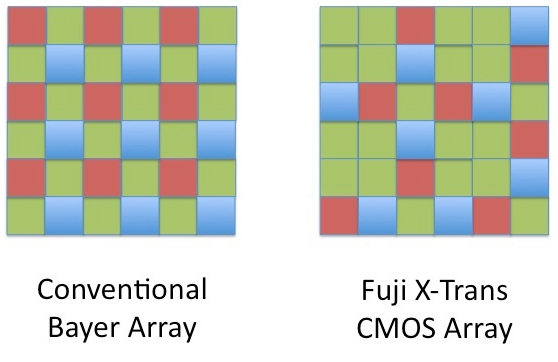The X-Trans sensor and the false details

The Yin & Yang, the good and the bad, of the X-Trans sensor, goes into the next round.
Now, we all know about the benefits of this technology… but occasionally also critics circulate on the web. Sometimes these critics turn out to be unfair (for example the “Ghosting Issue” where X-Trans was accused to create, rarely, red dots / artifacts when shooting against the sun… it turned out to be an issue with all mirrorless cameras) but what about the “false details” issue raised by Zachery on his google+ account? Is this another “unfair criticism” or not?
Now here is what I’ve found until now on the web:
The problem
1) In his post here Zachery says: “The fact is, the X-trans sensor design utterly fails at its implied capability: It does not produce better details than a 16mp sensor with an anti-aliasing filter. It just produces wrong details. And this is best case. If you were to take this same image except use green lines, it would just be a blurry smudgefest due to the blocks of 2×2 green pixels on the X-Trans “semi-random” color filter array. And to add insult to injury, this sensor design does not entirely prevent moiré, which was the entire impetus behind a 3×3 semi-random color filter array.”
The reactions
1) Donovan sent me his post about this issue via FR-twitter: “The false detail does seem to be a real thing, but from what I can tell, it isn’t going to appear in much real-world photography. This building image has to be on the bad end of the spectrum, and I haven’t noticed anything like this at all in other images, and I’m just shy of having created 5,000 images on X-Trans sensors. For me, it’s an acceptable trade-off for the kind of shooting I do, and all the benefits the sensor brings. If you’re a heavy-duty architectural shooter, you might want to give this some consideration, but this is truly the only time I’ve noticed this behaviour.” Read more on his website.
2) And here is soundimageplus answer to this issue: “Now it’s easy to just say that this is all the result of some pixel-peeping nerd taking things to far. But then from time to time, I’m a pixel-peeping nerd too. It IS important to be critical of what we see, and if there are faults and / or things that could / should be improved then we need to say so […] But it’s important to put these things in context. […] For me and what I shoot, the Fuji X-Trans sensor gives me a lot of what I want, fulfills my ‘vision’ and gives me something close to what I wanted to capture when I pressed the shutter. And it does this a way that I find more appealing than many other camera / sensor combinations.”
3) And, when there is something wrong with Fuji cameras, you can also check out photosfujiscanttake here and his sarcastic answer to Zachery’s post.
4) Frank did a bit of pixel peeping and wrote me this email: “look at the DPreview new test scene at the floor of the black and white painting (left middle) where the small dog is. You see the diagonal stripes going just in the wrong direction (compare with Phase One IQ180). Canon, Nikon and Sony, even the new A7 seem to have the same problem. So if this is the same problem, it might not be caused by the X-Trans sensor? Have fun with pixel-peeping. Here is the link for the DPreview site. The zoom window is already located on the right painting. Tear down this zoom window a bit to the floor (below the tripod) of this painting and you see the diagonal lines directing in the wrong direction. That’s not only true for the X-M1 but also the NEX-6 and the EOS 100D. Select Phase One IQ180 in one window and you see how it should look like. A lot of cameras have problems with these diagonal lines even the new 24 megapixel Sony A7 has big problems. So there seems to be no specific reason to worry about the X-Trans sensor.”
Now what is your experience? Did you ever noticed this issue? Feel free to drop a comment.

